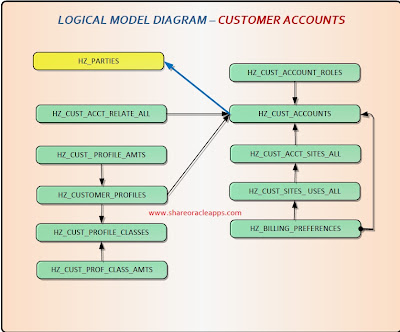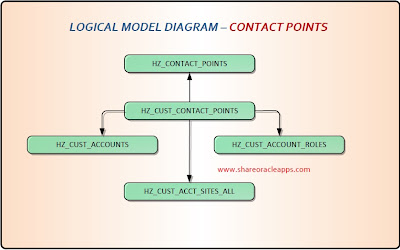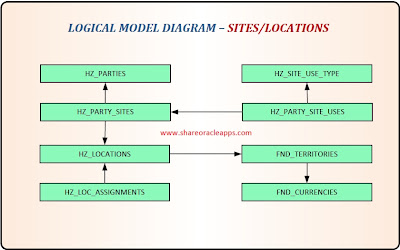PARTIES
The related tables are as follows:-
- HZ_PARTIES : Stores information about parties.
- HZ_FINANCIAL_PROFILE : Stores information about the financial accounts.
- HZ_CREDIT_RATINGS : Stores information about the credit rating of parties
- HZ_REFERENCES : Stores information about reference given by one party about another.
- HZ_CERTIFICATIONS : Stores information about the certifications given by other parties.
LOGICAL MODEL DIAGRAM
PARTIES – TYPE PERSON
The tables are as follows:-
- HZ_PERSON_PROFILES : Stores details information about people.
- HZ_PERSON_LANGUAGES :Stores information about the language that a person speaks, reads or writes
- HZ_PERSON_INTEREST : Stores information about a person’s personal interests.
- HZ_ CITIZENSHIP : Stores information about a person’s claimed nationality.
- HZ_EDUCATIONS : Store information about a person educations.
- HZ_EMPLOYMENT_HISTORY : Stores information about where the person has been employed.
LOGICAL MODEL DIAGRAM
PARTIES – TYPE ORGANIZATION
The tables are as follows:-
- HZ_ORGANIZATION_PROFILES : Stores details information about credit rating, financial statistics, socio-economic and corporate linkage information.
- HZ_STOCK_MARKETS :Stores information about the selling and buying of financial instruments.
- HZ_SECURITY_ISSUED : Stores information about financial instruments such as stocks and bonds that has been issued by the organization.
- HZ_INDUSTRIAL_CLASS_APP : It is a intersection tables that link industrial classifications stores in HZ_INDUSTRIAL_CLASSES .
- HZ_INDUSTRIAL_CLASSES : Stores information about names and descriptions of industrial classifications.
- HZ_FINANCIAL_REPORTS : Store information details of financial reports that describe the financial status of the party.
- HZ_INDUSTRIAL_REFERENCE : Stores information about industrial reference for organization.
LOGICAL MODEL DIAGRAM
CUSTOMER ACCOUNTS
The tables are as follows:-
- HZ_CUST_ACCOUNTS : Stores information about the relationship, if a party becomes a customer. Basically stores information about customer accounts.
- HZ_CUST_ACCT_SITES_ALL : Stores information about customer sites. One customer can have more then multiple sites.
- HZ_CUST_SITE_USES_ALL : Stores information about site uses or business purpose. A Single customer site can have multiple sites uses such as Bill To or Ship To.
- HZ_CUST_ACCT_RELATE_ALL : Stores information about relationships between customer accounts.
- HZ_CUST_ACCOUNT_ROLES : Stores information about the roles that parties perform in customer accounts.
- HZ_BILLING_PREFERENCES : It describe the invoicing format preferred by customer accounts or customer account sites.
- HZ_CUSTOMER_PROFILES : Stores credit information for a customer account and customer account sites.
- HZ_CUST_PROFILE_AMTS : Stores profile amount limits for every currency defined for a customer account or customer account site profile.
- HZ_CUST_PROF_CLASS_AMTS :Stores customer profile class amount limits for currency.
- HZ_CUST_PROFILE_CLASSES : Stores standard credit profile classes.
LOGICAL MODEL DIAGRAM
CONTACT POINTS
The tables are as follows:-
- HZ_CONTACT_POINTS : Stores electronic methods of communicating with entities such as parties, party site. Each record in this table represents s different means of contacting an entity.
- HZ_CUST_CONTACT_POINTS : This table is used to tie a contact point to a customer account, customer account site or customer account role.
- HZ_CONTACT_RESTRICTIONS : It stores information about restrictions on contacting parties.
LOGICAL MODEL DIAGRAM
SITES/LOCATIONS
The tables are as follows:-
- HZ_PARTIES_SITES : Stores information about parties and locations. Because there is a many-to-many relationship between parties and locations.
- HZ_PARTIES_SITE_USES : Stores information about the party site uses and business purposes. A party site can have multiple site uses such as ‘bill to’ or ‘ship to’ and each site is stores as a record in this table.
- HZ_LOCATIONS : Stores information about the locations, namely, address information
- HZ_LOC_ASSIGNMENTS : It ties locations stored in HZ_LOCATIONS to a LOC_ID stored in AR_LOCATIONS_COMBINATIONS




